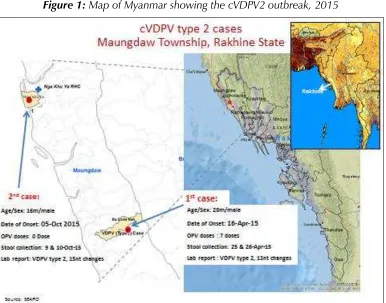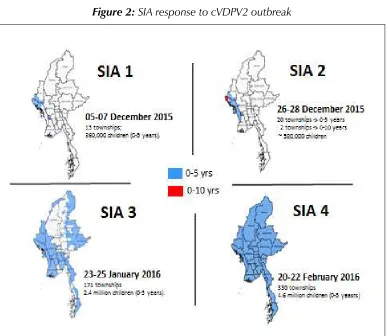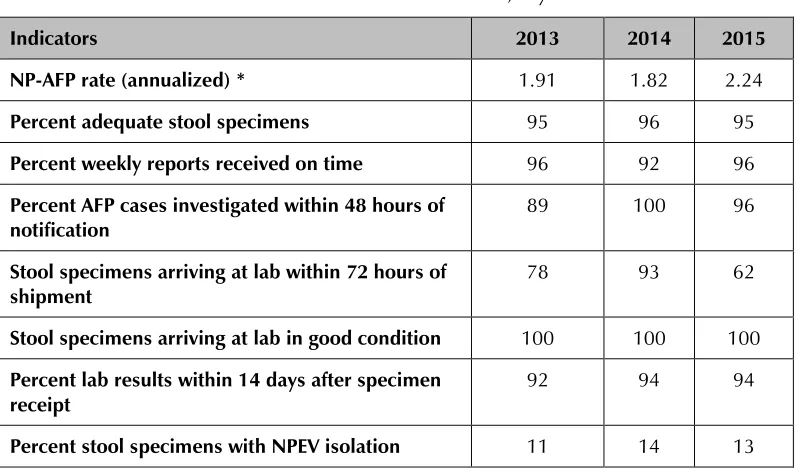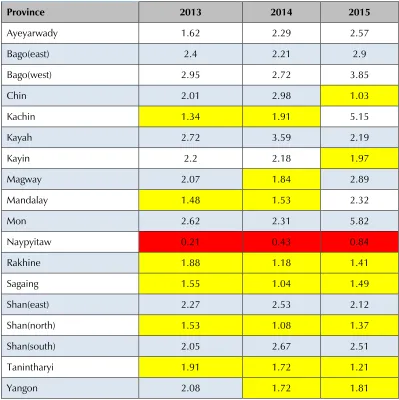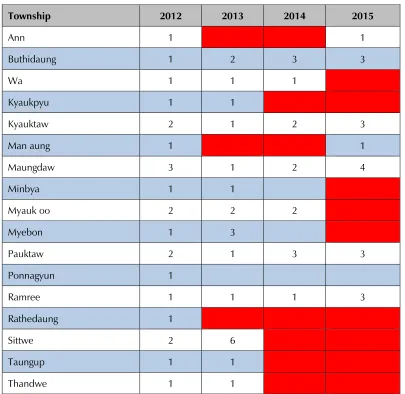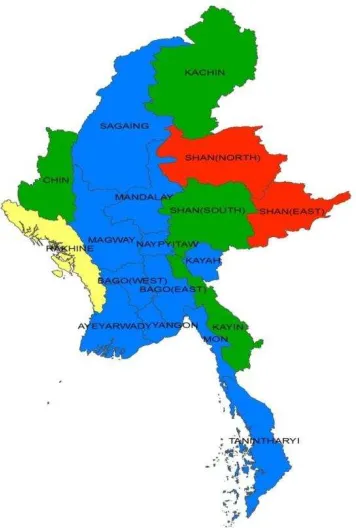SEA-Immun-98 Distribution: General
External 3-Month Assessment:
cVDPV2 Outbreak Response
© World Health Organization 2016
All rights reserved.
Requests for publications, or for permission to reproduce or translate WHO publications – whether for sale or for noncommercial distribution – can be obtained from SEARO Library, World Health Organization, Regional Office for South-East Asia, Indraprastha Estate, Mahatma Gandhi Marg, New Delhi 110 002, India (fax: +91 11 23370197; e-mail: [email protected]).
The designations employed and the presentation of the material in this publication do not imply the expression of any opinion whatsoever on the part of the World Health Organization concerning the legal status of any country, territory, city or area or of its authorities, or concerning the delimitation of its frontiers or boundaries. Dotted lines on maps represent approximate border lines for which there may not yet be full agreement.
The mention of specific companies or of certain manufacturers’ products does not imply that they are endorsed or recommended by the World Health Organization in preference to others of a similar nature that are not mentioned. Errors and omissions excepted, the names of proprietary products are distinguished by initial capital letters.
All reasonable precautions have been taken by the World Health Organization to verify the information contained in this publication. However, the published material is being distributed without warranty of any kind, either expressed or implied. The responsibility for the interpretation and use of the material lies with the reader. In no event shall the World Health Organization be liable for damages arising from its use. This publication does not necessarily represent the decisions or policies of the World Health Organization.
Contents
Page
Acronyms ... v
Executive summary ... vii
1. Objectives of the outbreak response assessment ... 1
2. Background ... 1
3. Methodology of the outbreak response assessment ... 3
4. Observations and conclusions of the assessment teams ... 6
5. Conclusions ... 16
6. Recommendations ... 16
7. Acknowledgement ... 18
Acronyms
AFP acute flaccid paralysis
cVDPV circulating vaccine-derived poliovirus
EAPRO Regional Office for East Asia and the PacificUNICEF GPEI Global Polio Eradication Initiative
IEC information, education and communication IDP internally displaced population
IHR (2005) International Health Regulations (2005) INGO international nongovernmental organization MoH Ministry of Health
NP-AFP non-polio acute flaccid paralysis OBRA outbreak response assessment OPV oral polio vaccine
ORI outbreak response immunization PCM post-campaign monitoring POL3 polio immunization, third dose RCA rapid coverage assessment RI routine immunization RSO Regional surveillance officer SEARO Regional Office for South-East Asia SIA supplementary immunization activity tOPV trivalent oral polio vaccine
Executive summary
An outbreak of circulating vaccine-derived poliovirus (cVDPV) type 2 in Rakhine state, Myanmar, was confirmed in December 2015. A national public health emergency was declared in the country and considerable resources from the Ministry of Health, development partners, international nongovernmental organizations (INGOs) and nongovernmental organizations (NGOs) were mobilized to implement an outbreak response plan. Four rounds of supplementary immunization activities (SIAs) with trivalent oral polio vaccine (tOPV) were conducted between December 2015 and February 2016. These included three subnational vaccination campaigns and one nationwide campaign. Efforts to strengthen surveillance activities for poliovirus detection as well as to improve routine immunization (RI) coverage were also initiated in the outbreak-affected areas.
An inter-agency team comprising experts from the World Health Organization
(WHO) and United Nations Children’s Fund (UNICEF) headquarters, regional and
country offices conducted an outbreak response assessment (OBRA) in Myanmar from 28 March to 5 April 2016. The objectives of the assessment were to evaluate the adequacy and quality of the outbreak response and to determine whether poliovirus transmission had been interrupted following the activities undertaken. The assessment involved extensive field visits, covering multiple townships in five provinces, desk analysis of the acute flaccid paralysis (AFP) data and laboratory reports, review of programme documents and face-to-face interviews with health officials, community leaders, administrators and representatives from NGOs and INGOs.
1.
Objectives of the outbreak response assessment
Assess the quality and adequacy of polio outbreak response activities to evaluate whether the response is on track to interrupt polio transmission, as per World Health Assembly established standards.
Provide additional technical recommendations to assist the country to meet this goal.
2.
Background
External 3-Month Assessment: cVDPV2 Outbreak Response
2
Figure 1: Map of Myanmar showing the cVDPV2 outbreak, 2015
Source: WHO South-East Asia Region data as of March 2016
Following the confirmation of the outbreak, the Director-General of Public Health, along with senior technical staff of the Ministry of Health, Myanmar, visited the affected township (Maungdaw) and adjoining township (Buthidaung), demonstrating a strong political will and commitment to respond to the polio outbreak. The Chief Minister of Rakhine launched the polio vaccination campaign in affected townships.
External 3-Month Assessment: cVDPV2 Outbreak Response
during the second SIA. A total of 171 townships targeting 2.4 million children (0-5 years) were included for coverage during the third SIA on 23 January 2016. The fourth SIA was a nationwide campaign conducted on 20 February 2016 targeting 4.6 million children (0-5 years) in 330 townships of the country.
Table 1: Timeline of events after outbreak confirmation, Myanmar 2015
cVDPV2 outbreak
Source: WHO South-East Asia Region data as of March 2016
3.
Methodology of the outbreak response
assessment
WHO and UNICEF, in close coordination with the Ministry of Health, conducted an external assessment from 28 March to 5 April 2016 in Myanmar, to evaluate the effect of outbreak response in interrupting the polio virus transmission activities according to World Health Assembly resolution WHA59.1 in 2006. Five teams comprising experts from WHO and UNICEF headquarters, regional offices, country office and officials from the Ministry of Health, Myanmar, visited the following states/townships:
(1) Rakhine state, Maungdaw township
(a) Dr Abu Obeida Babiker (UNICEF-EAPRO) (b) Dr Ye ZinZin (WHO-Myanmar)
External 3-Month Assessment: cVDPV2 Outbreak Response
4
(2) Yangon and Nay Pyi Taw states (a) Dr Graham Tallis (WHO-HQ) (b) Dr Tin Tin Aye (WHO-Myanmar) (c) Dr Tin ThitsarLwin (MoH-Myanmar) (d) Dr Ag Myat Htay (RSO, WHO-Myanmar) (3) Shan East state, Kyentong, Tarchileik township
(a) Dr Suleman Rahim Malik (UNICEF-HQ) (b) Dr Aung NaingOo (WHO-Myanmar)
(4) Mandalay Region (Urban) PyinOoLwin, Yamethin township (a) Dr Hasan ASM Mainul (UNICEF-HQ)
(b) Dr Tin Htut (UNICEF-Myanmar) (c) Dr HninNweni Aye (MoH-Myanmar)
(d) Dr Myo Thant Khine (RSO, WHO-Myanmar) (e) Dr Su Mon Kyaw (UNICEF-Mandalay Office) (5) Rakhine State, Sittwe and Pauktaw townships
(a) Dr Sudhir Khanal (WHO-SEARO) (b) Dr Allison Gocotano (WHO-Myanmar) (c) Dr ThihaHtun (UNICEF-Myanmar) (d) Dr Aung Kyaw Moe (MoH-Myanmar)
External 3-Month Assessment: cVDPV2 Outbreak Response
A detailed review of the field assessments by the inter-agency teams of external experts was done on 4 April 2016. The findings and recommendations of the outbreak report assessment (OBRA) were shared with the Ministry of Health, Government of Myanmar on 5 April 2016.
The three-month OBRA was designed to determine if adequate and appropriate measures had been undertaken, following the confirmation of the type 2 cVDPV outbreak in Myanmar.
Seven key areas were assessed to evaluate whether the outbreak response complied with the World Health Assembly-established standards. The seven areas included the following:
(1) Did the outbreak response activities meet the outbreak response standards, particularly in terms of speed and appropriateness? (2) Have national authorities and partners played their expected
role as laid down in World Health Assembly and Regional Committee resolutions?
(3) Has SIA quality been sufficient to ensure that poliovirus transmission is interrupted within the shortest time possible? What was the quality of SIA planning, delivery, monitoring and communication?
(4) Is the AFP surveillance system sensitive enough to detect transmission?
(5) Have the polio outbreak response activities been undertaken in a manner that would strengthen RI performance, particularly in the highest risk areas?
(6) Have sufficient financial, material and human resources been made available to support full implementation of all recommended polio outbreak response activities?
External 3-Month Assessment: cVDPV2 Outbreak Response
6
4.
Observations and conclusions of the assessment
teams
4.1
Did the outbreak response activities meet the outbreak
response standards, particularly in terms of speed and
appropriateness?
The outbreak response in Myanmar met nearly all the established standards, particularly in terms of speed and appropriateness, as the response plan was prepared and adhered to during the implementation of the outbreak response activity. The steering committee meeting organized and chaired by the Union Minister, during the last quarter of 2015, confirms that sufficient importance was given to the outbreak response to contain the spread of polio in the community. The outbreak activities were initiated on the ground despite some delay in finalization of the formal outbreak plan, which took longer than the defined time period of two weeks. Effective steps to curb the spread of cVDPV could begin because the national authorities were well-sensitized to the existing ground realities particularly to the gaps in RI and AFP surveillance in the hard-to-reach townships.
External 3-Month Assessment: cVDPV2 Outbreak Response
Figure 2: SIA response to cVDPV2 outbreak
Source: WHO South-East Asia Region data as of March 2016
External 3-Month Assessment: cVDPV2 Outbreak Response
8
4.2
Have national authorities and partners played their expected
role as laid down in WHA and RC resolutions?
Outbreak focal point for Ministry of Health, WHO, UNICEF designated in first week of outbreak
YES
Weekly calls with WHO HQ and Regional Office on outbreak YES Weekly calls with UNICEF HQ and Regional Office on outbreak took place YES Weekly technical coordination meetings chaired by government and attended
by all partners at national and subnational level
YES
Funds for outbreak response disbursed on time NO*
*Funds were delayed during the third and fourth SIA; however, activities were not compromised despite the delay.
The involvement of administrative, political and religious heads at central, state and township levels was evident. A health sector coordination committee meeting had been organized in Rakhine state. Visits to the affected township (Maungdaw) and adjoining township (Buthidaung) were made by the Director-General, Deputy Director-General and senior technical staff from the Ministry of Health as well as by technical experts from the regional and country offices of WHO and UNICEF.
Country focal points for the outbreak response from WHO and UNICEF were designated, and they participated in weekly technical coordination meetings that were chaired by government officials. Adequate budgetary provisions were in place for outbreak management and although funds disbursement was delayed during the third and fourth SIAs, activities on the ground were not compromised.
External 3-Month Assessment: cVDPV2 Outbreak Response
4.3
Has SIA quality been sufficient to ensure that poliovirus
transmission is interrupted within shortest time possible?
What was the quality of SIA planning, delivery, monitoring
and communication?
National guidelines for SIA preparation and implementation available
YES
SIA priority activities as per national plan implemented YES
Overall quality of SIAs V. GOOD
Quality of SIAs in highest risk areas GOOD (SOME GAPS) Strategies to reach insecure areas, mobile populations YES (NEED TO
IMPROVE)
Cross-border activities implemented PARTIAL*
* IHR Temporary Recommendations not being fully implemented.
National guidelines for SIA preparation and implementation were available and formed the basis for conducting all activities. Strategies to reach insecure areas and mobile populations had been implemented. Social mobilization activities helped to achieve high coverage in hard-to-reach populations and the internally displaced populations (IDP) during the SIAs.
Cross-border activities had been implemented by setting up vaccination posts along the Myanmar-Bangladesh border. More than 7000 children were reported vaccinated in Sittwe township of Rakhine state through cross-border activities conducted between 5 December 2015 and 29 February 2016. In addition, OPV birth dose was introduced in Maungdaw and Buthidaung townships and an immunization post was set up at the border point that had population movement with Bangladesh. However, some gaps were identified in the immunization coverage at the bordering areas in Chin province, along the Myanmar-Thailand border.
External 3-Month Assessment: cVDPV2 Outbreak Response
10
Pre-campaign activities conducted in Myanmar included advocacy meetings with local leaders and training of vaccinators – which included training on SIA implementation, AFP surveillance, RI and planning for social mobilization. Efforts to cover the hard-to-reach populations in the villages and camps during the house-to-house visits had been conducted. House markings were observed by the team in all places visited in townships of the outbreak. The vaccination sites were found to have been monitored by supervisors, and checklists had been duly filled.
Post-campaign rapid coverage assessment (RCA) had been conducted by partner agencies and INGOs working in the area and the RCA findings were matching with the administrative reported coverages. In all places the denominators used were the household head count and not the projected population provided by the government. In Sittwe, the RCA conducted by external monitors confirmed coverage to be around 97%.
The use of invitation and information cards during the campaign was implemented as an innovative method for community participation. Materials for information, education and communication (IEC) had been developed and distributed. The material was developed in the national language; however, timely availability was a concern in some states. There was no issue of acceptance of vaccine in any of the areas.
The field visits confirmed that the four SIAs were of high quality with high coverage.
4.4
Is the AFP surveillance system sensitive enough to detect
transmission?
External 3-Month Assessment: cVDPV2 Outbreak Response
Table 2: AFP surveillance indicators, Myanmar
Indicators 2013 2014 2015
NP-AFP rate (annualized) * 1.91 1.82 2.24
Percent adequate stool specimens 95 96 95
Percent weekly reports received on time 96 92 96
Percent AFP cases investigated within 48 hours of notification
89 100 96
Stool specimens arriving at lab within 72 hours of shipment
78 93 62
Stool specimens arriving at lab in good condition 100 100 100
Percent lab results within 14 days after specimen receipt
92 94 94
Percent stool specimens with NPEV isolation 11 14 13
*Per 100 000 population under 15 years of age.
While there was an overall improvement in the surveillance indicators at the national level, suboptimal surveillance quality continued in a number of states. Nine of the 17 states did not achieve the NP-AFP rate of
External 3-Month Assessment: cVDPV2 Outbreak Response
12
Table 3: NP-AFP rate by state, Myanmar
Province 2013 2014 2015
Ayeyarwady 1.62 2.29 2.57
Bago(east) 2.4 2.21 2.9
Bago(west) 2.95 2.72 3.85
Chin 2.01 2.98 1.03
Kachin 1.34 1.91 5.15
Kayah 2.72 3.59 2.19
Kayin 2.2 2.18 1.97
Magway 2.07 1.84 2.89
Mandalay 1.48 1.53 2.32
Mon 2.62 2.31 5.82
Naypyitaw 0.21 0.43 0.84
Rakhine 1.88 1.18 1.41
Sagaing 1.55 1.04 1.49
Shan(east) 2.27 2.53 2.12
Shan(north) 1.53 1.08 1.37
Shan(south) 2.05 2.67 2.51
Tanintharyi 1.91 1.72 1.21
External 3-Month Assessment: cVDPV2 Outbreak Response
Table 4: Number of AFP cases by township, Rakhine state
Township 2012 2013 2014 2015
Ann 1 1
Buthidaung 1 2 3 3
Wa 1 1 1
Kyaukpyu 1 1
Kyauktaw 2 1 2 3
Man aung 1 1
Maungdaw 3 1 2 4
Minbya 1 1
Myauk oo 2 2 2
Myebon 1 3
Pauktaw 2 1 3 3
Ponnagyun 1
Ramree 1 1 1 3
Rathedaung 1
Sittwe 2 6
Taungup 1 1
Thandwe 1 1
The assessment team concluded that the AFP surveillance system in Myanmar is not sensitive enough to detect polioviruses. In view of this, the team could not conclude whether transmission of cVDP2 had been interrupted or not in Myanmar.
External 3-Month Assessment: cVDPV2 Outbreak Response
14
4.5
Have the polio outbreak response activities been undertaken
in a manner that would strengthen RI performance,
particularly in the highest-risk areas?
The last five-year data analysis regarding POL 3 coverage in less than one-year-old population demonstrates a deterioration of RI coverage in selected areas of the country, following the civil conflict in 2012. (Refer to Table 5 & Figure 3). The low RI in the outbreak area is the probable cause for the emergence of cVDPV Type 2 in Myanmar.
Table 5: National, Rakhine and township POL 3 (%) coverage during the last five years
POL 3 coverage (%) in Myanmar (<1 year old)
Year 2011 2012 2013 2014 2015
Myanmar 90 87 76 88 89
Rakhine 91 70 44 70 72
Mungdaw 97 50 21 55 68
Sittwe 86 46 24 27 31
External 3-Month Assessment: cVDPV2 Outbreak Response
Figure 3: National RI coverage, 2015
Source: WHO South-East Asia Region data as of March 2016
4.6
Have sufficient financial, material and human resources
been made available to support full implementation of all
recommended polio outbreak response activities?
Adequate human resource surge support through local NGOs and UN partners was available and had been utilized to coordinate the outbreak response and support other activities of outbreak response, including developing the appropriate communication for development strategies for the outbreak and RI. The funding provisions by Global Polio Eradication Initiative were sufficient and timely. Appropriate logistic support was maintained by the development partners during the outbreak response. The adequate availability of tOPV was ensured for conducting the outbreak response immunization activities.
External 3-Month Assessment: cVDPV2 Outbreak Response
16
4.7
What are the remaining risks to stopping the outbreak?
The undetected transmission of poliovirus due to AFP surveillance gaps poses a major risk to stopping the outbreak. The other challenge in the outbreak and neighbouring areas is the very low RI coverage. Suboptimal immunization of migrant and mobile populations during SIA and RI is another risk as it will facilitate continued transmission of VDPV2 and could also support its spread.
5.
Conclusions
The overall response by the national authorities, with support from WHO and UNICEF regional and country offices, has been strong and appropriate following the confirmation of the outbreak of cVDPV2 in Myanmar. The overall SIA planning and quality has been good and in accordance with WHA guidelines. Adequate funds and other logistics had been ensured to implement the planned outbreak response activities. RI coverage is suboptimal, especially in the outbreak area. The transmission of VDPV2 may have been interrupted; however, uncertainty in concluding this remains due to gaps in AFP surveillance quality in Myanmar. The risk of further cVDPV2 transmission after the switch has global implications; so, there exists an urgent need to address the gaps identified in outbreak response.
6.
Recommendations
A number of recommendations have been made by the assessment team. These have been categorized under the following four areas of work:
A. Supplementary immunization activity
Consider conducting an additional SIA in selected high-risk townships in Rakhine, prior to the switch.
External 3-Month Assessment: cVDPV2 Outbreak Response
Robust arrangements need to be made to withdraw all tOPV immediately after the SIA and before the switch.
A fully budgeted outbreak response plan should be developed to handle any Type 2 detection post-switch.
B. Surveillance
Urgent efforts should be made to improve AFP surveillance at the national and subnational levels to ensure sensitive surveillance in all subnational areas.
The feasibility of initiating environmental surveillance in Myanmar should be explored.
The two vacant positions of regional surveillance officers (RSOs) need to be filled on priority.
Ensure independent mobility for all RSOs to support active surveillance.
Ensure systematic sampling of (up to five) contacts of all AFP cases found in high-risk districts for a minimum of the next six months, based on standardized protocols to be developed and shared with targeted states by the end of May 2016.
C. Routine immunization
Develop plans to improve RI coverage, pursuing the principles of reaching every child, with a focus on high-risk outbreak townships, migrants, slums, pre-urban areas and hard-to-reach areas.
Develop and implement special plans for RI coverage improvement in areas with low reported coverage.
Ensure adequate human resources, financial provisions and adequate logistics to maintain and improve RI coverage.
External 3-Month Assessment: cVDPV2 Outbreak Response
18
Efforts undertaken during the current outbreak immunization response should be taken as a great opportunity to build trust between the community and health system for RI, especially in the outbreak areas.
D. Improve data quality
Improvement of data quality, particularly a proper denominator, should be a priority for SIAs, surveillance and RI.
Utilization of digital technology/Internet could be explored for reporting and data-quality assessment.
